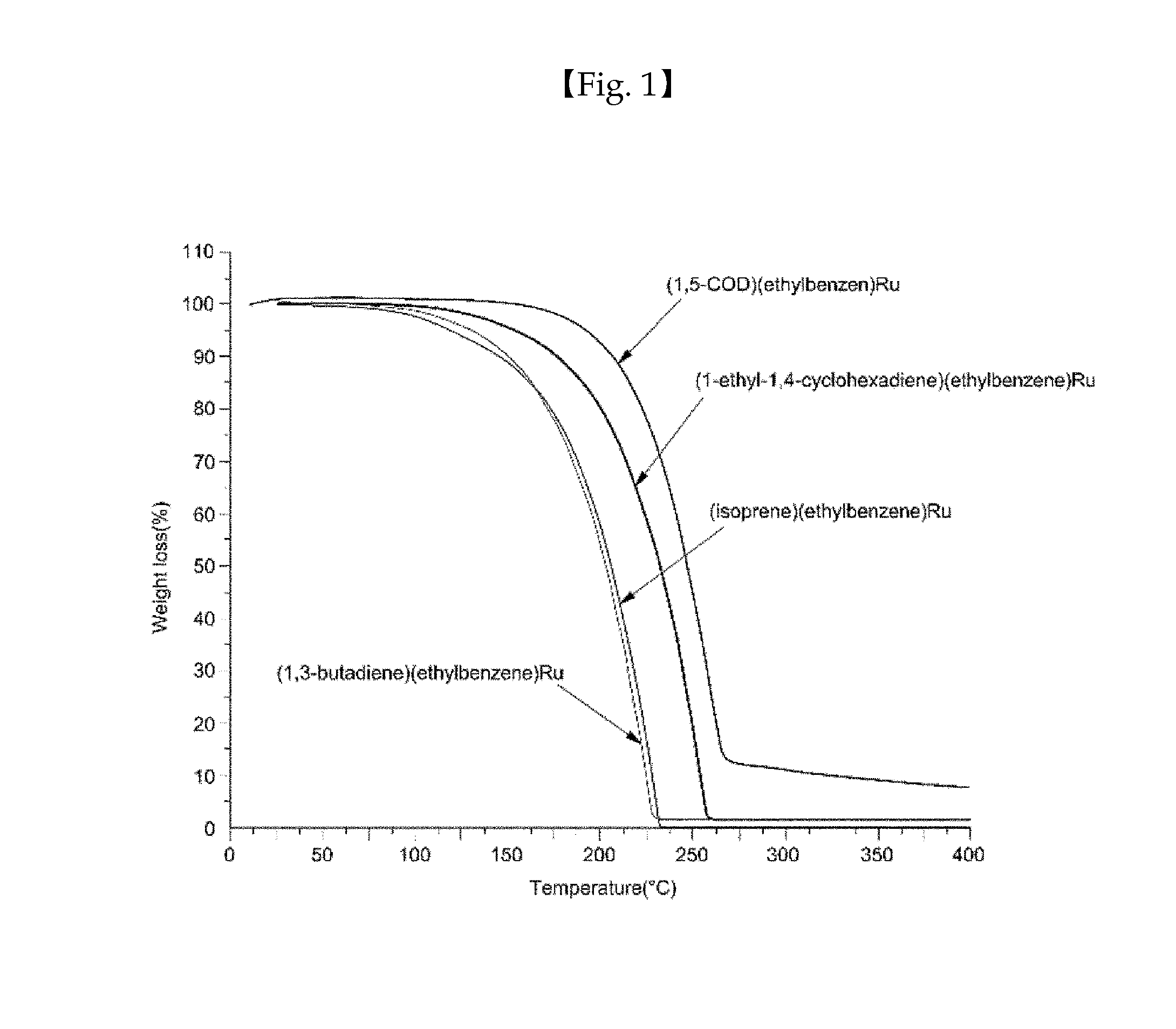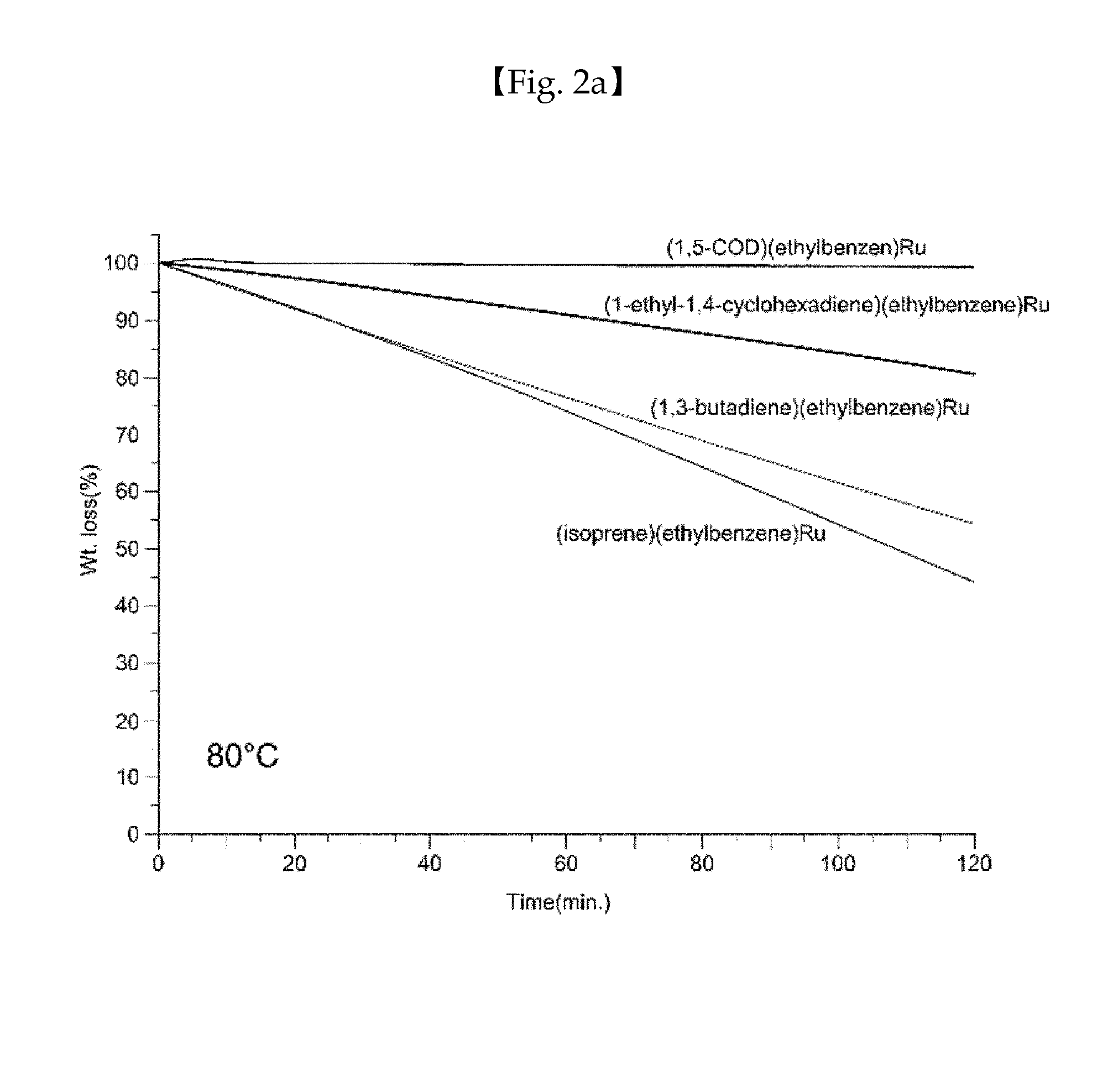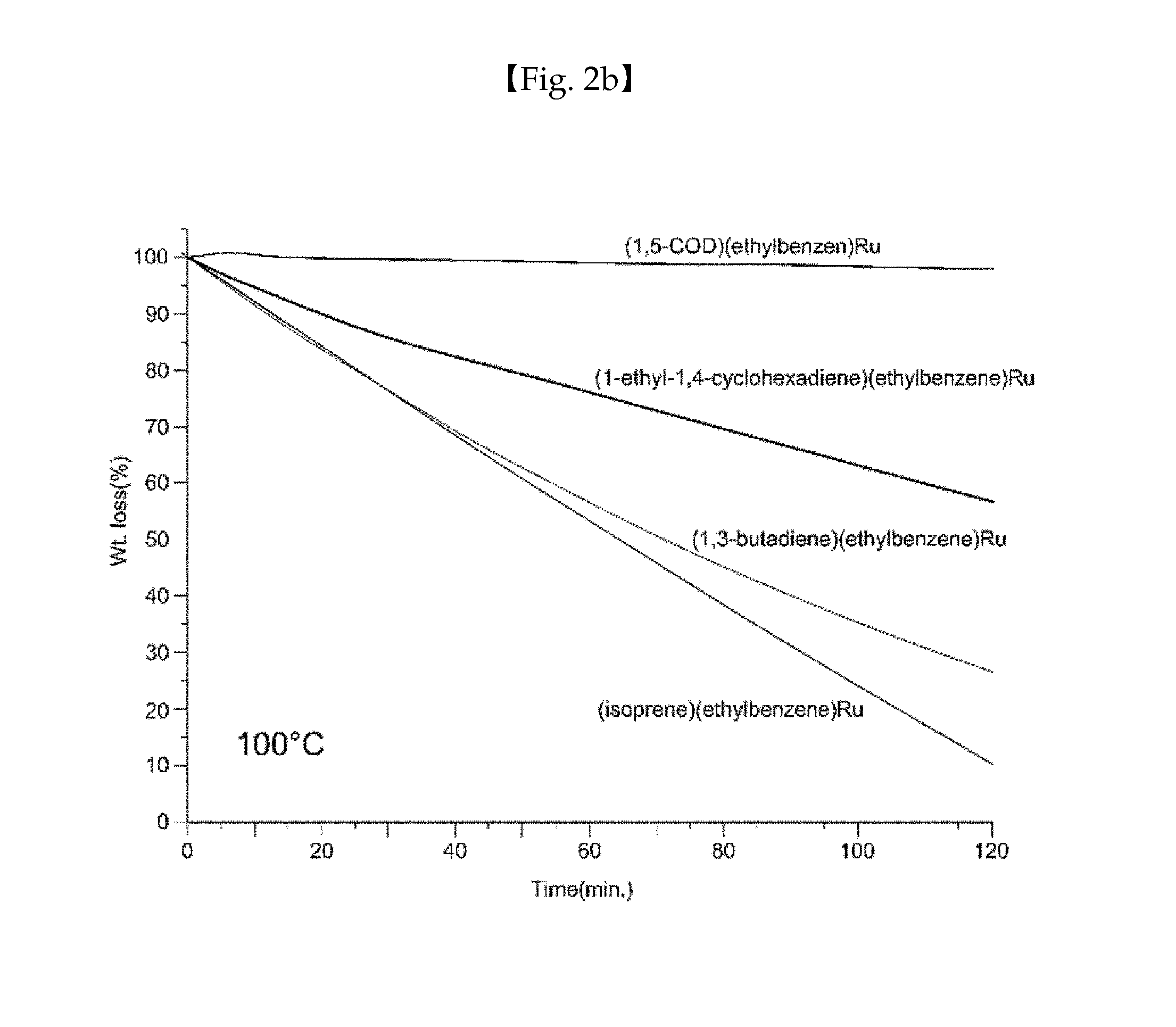Ruthenium compound having superior step coverage and thin film deposited using same
a technology of ruthenium compound and step coverage, which is applied in the field of ruthenium compound having superior step coverage and thin film deposited using same, can solve the problems of inapplicability to large-scale production, and achieve the effects of high step coverage, superior thermal stability, and high vapor pressur
- Summary
- Abstract
- Description
- Claims
- Application Information
AI Technical Summary
Benefits of technology
Problems solved by technology
Method used
Image
Examples
example 1
on of (1-ethyl-1,4-cyclohexadiene)(ethylbenzene)ruthenium
[0029]The dimer ethylbenzene ruthenium dichloride (150 g, 0.27 mol) and sodium carbonate (Na2CO3) (284 g, 2.68 mol) were weighed into a 2-L branched round flask. After adding 2-propanol (1000 mL) and stirring, 1-ethyl-1,4-cyclohexadiene (116 g, 1.07 mol) was added dropwise to the resulting mixture using a dropping funnel. Then, reaction was conducted for 10 hours under reflux using a reflux condenser.
[0030]Upon completion of the reaction, the resulting solution was filtered and the solvent and a volatile byproduct were removed under reduced pressure. After extraction with hexane, the solvent and the volatile byproduct were removed again under reduced pressure to obtain a viscous, dark reddish-brown solution. This liquid was distilled under reduced pressure to obtain 139 g (yield: 82%) of (1-ethyl-1,4-cyclohexadiene)(ethylbenzene)ruthenium as viscous yellow liquid.
[0031]Boiling point (b.p.): 116° C. / 0.23 torr.
[0032]Vapor pressu...
example 2
on of (1,3-butadiene)(ethylbenzene)ruthenium
[0034]The dimer ethylbenzene ruthenium dichloride (100 g, 0.18 mol) and sodium carbonate (Na2CO3) (114 g, 1.08 mol) were weighed into a 1-L branched round flask. After adding 2-propanol (500 mL) and stirring, 1,3-butadiene (250 g, 4.62 mol) was bubbled into the resulting mixture. Then, reaction was conducted for 2 days under reflux using a reflux condenser. Upon completion of the reaction, the resulting solution was filtered and the solvent and a volatile byproduct were removed under reduced pressure. After extraction with hexane, the solvent and the volatile byproduct were removed again under reduced pressure to obtain a viscous, dark reddish-brown solution. This liquid was distilled under reduced pressure to obtain 59 g (yield: 57%) of (1,3-butadiene)(ethylbenzene)ruthenium as viscous yellow liquid.
[0035]Boiling point (b.p.): 88° C. / 1.2 torr.
[0036]1H-NMR (C6D6, ppm): δ 0.286 ([CH2═CHCH═CH2]—Ru, d, 2H), 0.958 ([CH3CH2C6H5]—Ru, tr, 3H]), 1...
example 3
on of (isoprene)(ethylbenzene)ruthenium
[0037]The dimer ethylbenzene ruthenium dichloride (20 g, 0.036 mol) and sodium carbonate (Na2CO3) (13.09 g, 0.12 mol) were weighed into a 1-L branched round flask. After adding 2-propanol (150 mL) and stirring, isoprene (12.36 g, 0.18 mol) was added dropwise to the resulting mixture using a dropping funnel. Then, reaction was conducted for a day under reflux using a reflux condenser. Upon completion of the reaction, the resulting solution was filtered and the solvent and a volatile byproduct were removed under reduced pressure. After extraction with hexane, the solvent and the volatile byproduct were removed again under reduced pressure to obtain a viscous, dark reddish-brown solution. This liquid was distilled under reduced pressure to obtain (8.51 g, yield: 37%) of (isoprene)(ethylbenzene)ruthenium as viscous yellow liquid.
[0038]Boiling point (b.p.): 118° C. / 0.5 torr.
[0039]1H-NMR (C6D6, ppm): δ 0.175 ([CH2═CHCH3C═CH2]—Ru, d, 1H), 0.377 ([CH2═...
PUM
| Property | Measurement | Unit |
|---|---|---|
| Temperature | aaaaa | aaaaa |
| Temperature | aaaaa | aaaaa |
| Temperature | aaaaa | aaaaa |
Abstract
Description
Claims
Application Information
 Login to View More
Login to View More - R&D
- Intellectual Property
- Life Sciences
- Materials
- Tech Scout
- Unparalleled Data Quality
- Higher Quality Content
- 60% Fewer Hallucinations
Browse by: Latest US Patents, China's latest patents, Technical Efficacy Thesaurus, Application Domain, Technology Topic, Popular Technical Reports.
© 2025 PatSnap. All rights reserved.Legal|Privacy policy|Modern Slavery Act Transparency Statement|Sitemap|About US| Contact US: help@patsnap.com



